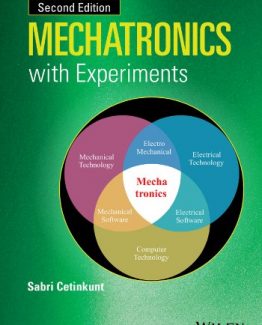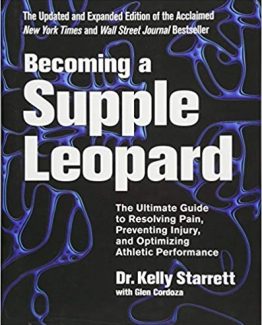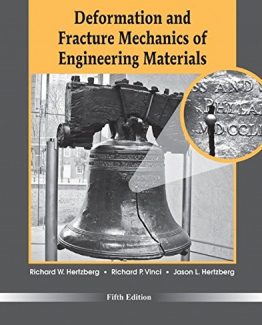Fundamentals of Industrial Instrumentation and Process Control 2nd Edition by William Dunn, ISBN-13: 978-1260122251
[PDF eBook eTextbook]
- Publisher: McGraw Hill; 2nd edition (July 13, 2018)
- Language: English
- 336 pages
- ISBN-10: 1260122255
- ISBN-13: 978-1260122251
A Fully Updated, Practical Guide to Automated Process Control and Measurement Systems.
This thoroughly revised guide offers students a solid grounding in process control principles along with real-world applications and insights from the factory floor. Written by an experienced engineering educator, Fundamentals of Industrial Instrumentation and Process Control, Second Edition is written in a clear, logically organized manner. The book features realistic problems, real-world examples, and detailed illustrations. You’ll get clear explanations of digital and analog components, including pneumatics, actuators, and regulators, and comprehensive discussions on the entire range of industrial processes.
Fundamentals of Industrial Instrumentation and Process Control, Second Edition covers:
• Pressure
• Level
• Flow
• Temperature and heat
• Humidity, density, viscosity, & pH
• Position, motion, and force
• Safety and alarm
• Electrical instruments and conditioning
• Regulators, valves, and actuators
• Process control
• Documentation and symbol standards
• Signal transmission
• Logic gates
• Programmable Logic controllers
• Motor control
• And much more
Table of Contents:
Preface
Acknowledgment
1 Introduction
Chapter Objectives
1.1 Introduction
1.1.1 History
1.2 Process Control
1.3 Definition of the Elements in a Control Loop
1.4 Process Facility Considerations
1.5 Units and Standards
1.6 Instrument Accuracy
Summary
Problems
2 Pressure
Chapter Objectives
2.1 Introduction
2.2 Basic Terms
2.2.1 Density
2.2.2 Impact Pressure
2.3 Pressure Measurements
2.4 Pressure Formulas
2.5 Measuring Instruments
2.5.1 Manometers
2.5.2 Diaphragms, Capsules, and Bellows
2.5.3 Bourdon Tubes
2.5.4 Other Pressure Sensors
2.5.5 Vacuum Instruments
2.6 Application Considerations
2.6.1 Selection
2.6.2 Installation
2.6.3 Calibration
Summary
Problems
3 Level
Chapter Objectives
3.1 Introduction
3.2 Level Formulas
3.3 Level Sensing Devices
3.3.1 Direct Level Sensing
3.3.2 Indirect Level Sensing
3.4 Application Considerations
Summary
Problems
4 Flow
Chapter Objectives
4.1 Introduction
4.2 Basic Terms
4.3 Flow Formulas
4.3.1 Continuity Equation
4.3.2 Bernoulli Equation
4.3.3 Flow Losses
4.4 Flow Measurement Instruments
4.4.1 Flow Rate
4.4.2 Total Flow
4.4.3 Mass Flow
4.4.4 Dry Particulate Flow Rate
4.4.5 Open Channel Flow
4.5 Application Considerations
4.5.1 Selection
4.5.2 Installation
4.5.3 Calibration
Summary
Problems
5 Temperature and Heat
Chapter Objectives
5.1 Introduction
5.2 Basic Terms
5.2.1 Temperature Definitions
5.2.2 Heat Definitions
5.2.3 Thermal Expansion Definitions
5.3 Temperature and Heat Formulas
5.3.1 Temperature
5.3.2 Heat Transfer
5.3.3 Thermal Expansion
5.4 Temperature Measuring Devices
5.4.1 Thermometers
5.4.2 Pressure-Spring Thermometers
5.4.3 Resistance Temperature Devices
5.4.4 Thermistors
5.4.5 Thermocouples
5.4.6 Semiconductors
5.5 Application Considerations
5.5.1 Selection
5.5.2 Range and Accuracy
5.5.3 Thermal Time Constant
5.5.4 Installation
5.5.5 Calibration
5.5.6 Protection
Summary
Problems
6 Humidity, Density, Viscosity, and pH
Chapter Objectives
6.1 Introduction
6.2 Humidity
6.2.1 Humidity Definitions
6.2.2 Humidity Measuring Devices
6.3 Density and Specific Gravity
6.3.1 Basic Terms
6.3.2 Density Measuring Devices
6.3.3 Density Application Considerations
6.4 Viscosity
6.4.1 Basic Terms
6.4.2 Viscosity Measuring Instruments
6.5 pH Measurements
6.5.1 Basic Terms
6.5.2 pH Measuring Devices
6.5.3 pH Application Considerations
Summary
Problems
7 Position, Motion, and Force
Chapter Objectives
7.1 Introduction
7.2 Position and Motion Sensing
7.2.1 Basic Position Definitions
7.2.2 ON/OFF Position Sensing
7.2.3 Motion and Distance Sensing
7.2.4 Rotation Sensing
7.2.5 Position Application Consideration
7.3 Force, Torque, and Load Cells
7.3.1 Basic Definitions of Force and Torque
7.3.2 Force and Torque Measuring Devices
7.3.3 Force and Torque Application Considerations
Summary
Problems
8 Safety and Alarm
Chapter Objectives
8.1 Introduction
8.2 Safety Hazards
8.2.1 Personnel Hazards
8.2.2 Environmental Hazards
8.2.3 Control Equipment Hazards
8.2.4 Process Equipment Hazards
8.3 Safety Sensors
8.3.1 Smoke and Fire Sensors
8.3.2 Heat Sensors
8.3.3 Gas Sensors
8.3.4 Artificial Senses Chemical Sensors
8.3.5 Radiation Detectors
8.4 Process Equipment Safety
8.4.1 Alarm and Trip Systems
8.4.2 Safety Instrumented Systems
8.4.3 Power Loss Fail Safe
8.4.4 Safety Instrumented System Example
8.5 Safety and Protection
8.5.1 Personnel Protection
8.5.2 Environmental Protection
8.5.3 Equipment Protection
Summary
Problems
9 Electrical Instruments and Conditioning
Chapter Objectives
9.1 Introduction
9.2 Instrument Parameters
9.2.1 Basic Terms
9.3 Transducers
9.3.1 Definitions
9.3.2 Visual Display Considerations
9.3.3 Mechanical Motion to Electrical Transducers
9.4 Operational Amplifiers
9.4.1 Voltage Amplifiers
9.4.2 Current Amplifiers
9.4.3 Differential Amplifiers
9.4.4 Converters
9.4.5 Buffer Amplifiers
9.4.6 Nonlinear Amplifiers
9.4.7 Instrument Amplifier
9.5 Signal Conditioning
9.5.1 Offset Zero
9.5.2 Span Adjustment
9.5.3 Linearization in Analog Circuits
9.5.4 Linearization in Digital Circuits
9.5.5 Temperature Correction
9.6 Bridge Circuits
9.6.1 DC Bridges
9.6.2 Current-Balanced Bridge
9.6.3 Strain Gauge Sensors
9.6.4 AC Bridges
9.6.5 Capacitive Sensors
9.6.6 Resistance Sensors
9.6.7 Magnetic Sensors
Summary
Problems
10 Regulators, Valves, and Actuators
Chapter Objectives
10.1 Introduction
10.2 Pressure Controllers
10.2.1 Regulators
10.2.2 Safety Valves
10.2.3 Level Regulators
10.3 Flow Control Actuators
10.3.1 Globe Valve
10.3.2 Flow Control
10.3.3 Butterfly Valve
10.3.4 Other Valve Types
10.3.5 Valve Characteristics
10.3.6 Valve Fail Safe
10.4 Actuators
10.4.1 Operation
10.4.2 Control Valves
10.5 Electronic Devices
10.6 Application Considerations
10.6.1 Valves
Summary
Problems
11 Process Control
Chapter Objectives
11.1 Introduction
11.2 Basic Terms
11.3 Control Modes
11.3.1 ON/OFF Action
11.3.2 Differential Action
11.3.3 Proportional Action
11.3.4 Derivative Action
11.3.5 Integral Action
11.3.6 PID Action
11.4 Implementation of Control Loops
11.4.1 ON/OFF Action Pneumatic Controller
11.4.2 ON/OFF Action Electrical Controller
11.4.3 PID Action Pneumatic Controller
11.4.4 PID Action Control Circuits
11.4.5 PID Electronic Controller
11.5 Digital Controllers
Summary
Problems
12 Documentation and Symbol Standards
Chapter Objectives
12.1 Introduction
12.2 System Documentation
12.2.1 Manuals
12.2.2 Alarm and Trip System Documentation
12.2.3 Safety Documentation
12.2.4 PLC Documentation
12.2.5 Circuit Diagrams
12.2.6 Bussing Information
12.3 Pipe and Identification Diagrams
12.3.1 Standardization
12.3.2 Interconnections
12.3.3 Instrument Symbols
12.3.4 Instrument Identification
12.4 Functional Symbols
12.4.1 Actuators
12.4.2 Primary Elements
12.4.3 Regulators
12.4.4 Math Functions
12.5 P and ID Drawings
Summary
Problems
13 Signal Transmission
Chapter Objectives
13.1 Introduction
13.2 Pneumatic Transmission
13.3 Analog Transmission
13.3.1 Noise Considerations
13.3.2 Voltage Signals
13.3.3 Current Signals
13.3.4 Signal Conversion
13.3.5 Thermocouples
13.3.6 Resistance Temperature Devices
13.4 Digital Transmission
13.4.1 Transmission Standards
13.4.2 Smart Sensors
13.4.3 Foundation Fieldbus and Profibus
13.5 Digital Signal Converters
13.5.1 Analog-to-Digital Conversion
13.5.2 Digital-to-Analog Conversion
13.6 Telemetry
13.6.1 Width Modulation
13.6.2 Frequency Shift Modulation
Summary
Problems
14 Logic Gates
Chapter Objectives
14.1 Introduction
14.2 Digital Numbers
14.2.1 Converting Binary Numbers to Decimal Numbers
14.2.2 Converting from Decimal to Binary
14.3 Digital Logic Gates
14.3.1 Buffer Gate
14.3.2 AND Gate
14.3.3 OR Gate
14.3.4 NOT Gate
14.3.5 Signal Inversion
14.3.6 XOR Gates
14.3.7 Logic Symbols
14.4 Boolean Algebra
14.5 Functional Building Blocks
Summary
Problems
15 Programmable Logic Controllers
Chapter Objectives
15.1 Introduction
15.2 Programmable Controller
15.3 Controller Operation
15.4 Input and Output Modules
15.4.1 Discrete Input Modules
15.4.2 Analog Input Modules
15.4.3 Special Function Input Modules
15.4.4 Discrete Output Modules
15.4.5 Analog Output Modules
15.4.6 Smart Input and Output Modules
15.5 Ladder Diagrams
15.5.1 Input and Output Symbols
15.5.2 Ladder Layout
15.5.3 Ladder Gate Equivalent
15.5.4 Ladder Applications
Summary
Problems
16 Motor Control
Chapter Objectives
16.1 Introduction
16.2 Motor Classification
16.3 Motor Operation
16.3.1 DC Motors
16.3.2 AC Motors
16.3.3 Single-Phase Motor
16.3.4 Three-Phase Motors
16.3.5 Universal Motors
16.3.6 Stepping Motors
16.3.7 Servomotors and Synchro Motors
16.4 Motor Ratings
16.4.1 Electrical Ratings
16.4.2 Control Equipment Ratings
16.4.3 Enclosure Standards
16.5 Motor Control Applications
16.5.1 Two- and Three-Wire Starting
16.5.2 Startup Control
16.5.3 Wound Rotor Motor
16.5.4 Speed Control
16.5.5 DC Motor
16.5.6 Actuator Control
16.5.7 Stepper Motor
16.6 Motor Protection
Summary
Problems
A Units
B Thermocouple Tables
C References and Information Resources
D Abbreviations
Glossary
Answers to Odd-Numbered Questions
Index
What makes us different?
• Instant Download
• Always Competitive Pricing
• 100% Privacy
• FREE Sample Available
• 24-7 LIVE Customer Support






Reviews
There are no reviews yet.